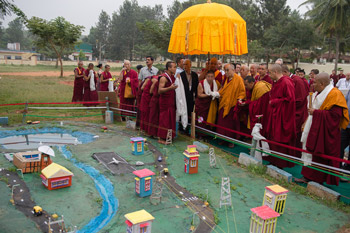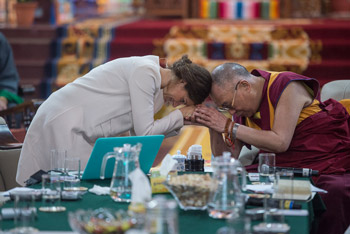Tibetet Segítő Társaság Sambhala Tibet Központ
Tibet Support Association Sambhala Tibet Center
székhely / telephely H-Budapest I. Attila út 123..
(00-36) 70 431 9343 (00-36)70 944 0260 (06-1)782 7721
sambhala@tibet.hu www.tibet.hu tibetpress.info
Facebook/Sambhala Tibet Központ Facebook/Tibett Segítő Társaság
MagnetBank/ 16200010-00110240
IBAN/HU94 16200010 00110240 00000000 SWIFT/HBWEHUHB
(1%) adószám/ 18061347-1-41
nyitva tartás/hétköznap 12.00-20.00 hétvégén előadás függő
» tibeti művészet» lapszemle.hu» thetibetpost.com» eastinfo.hu» rangzen.net» ChoegyalTenzin» tibet.net» phayul.com» DalaiLama.com» vilaghelyzete.blogspot.com» Videók» Linkek» TibetiHírek» Szerkesztőség
Day Two of Mind & Life Conference: Perceptions, Concepts and Self/ENG
2015. december 16./Dalailama.com/CTA/TibetPress
eredeti cikk
Bylakuppe, Karnataka, India, 15 December 2015 – Early this morning, under cloudy skies, His Holiness the Dalai Lama made several visits to other parts of Sera Monastery before the Mind & Life meetings resumed.
At Sera Jey members of the Mind & Life Institute joined him in visiting the Library of Tibetan Works & Archives Climate Change Exhibition. He also greeted Bobby Sager who has been a long term supporter of LTWA’s participation in the Monk-Science Education programme.
The Exhibition consisted of a series of displays, similar to Tibetan thangka paintings, illustrating aspects of climate change under headings such as How do Earth Systems Work? Earth’s Energy Balance, Weather or Climate, the Carbon Cycle and What Can We Do? Each display included explanations in Tibetan and English. Several monks and Library Director, Geshe Lhakdor, escorted His Holiness round the exhibition in which he took a close interest. At the end he remarked that it’s worth noting the place trees had in the Buddha’s life. He was born under a tree, was enlightened under the bodhi tree and passed away between two sal trees. Also, the Buddha gave monks instructions not only about planting trees, but on continuing to care for those planted by others before them, particularly during the rainy season retreat.
Sera Jey Secondary School was the next stop, where students had also mounted a substantial exhibition related specifically to water. Individual monks took turns explaining to him the displays outside in the garden and inside the school hall. Sitting on the stage, he responded:
“What you have shown me is very good, thank you. You should know that Nalanda University wasn’t just a place where people gathered to say prayers, but a centre for the study of the five sciences. Many learned people like Nagarjuna and his followers gathered there and it eventually became a centre for Buddhist studies. Now, Tibet is the only Buddhist country to have maintained the Nalanda tradition intact. We don’t have to know Sanskrit or Pali; we can access this tradition in our own language Tibetan because of the kindness of our ancestors who translated Indian Buddhist literature.
“I feel it’s consistent with the spirit of the Nalanda tradition to have added modern science to the curriculum in our schools and monasteries. Lay people and monastics should make the effort to raise the standard of education we provide, keeping in mind the need to care for both our external and internal environment.”
At Pobhor Khangtsen of Sera Mey Monastery, His Holiness unveiled a plaque and cut the ribbon across the door to inaugurate the new assembly hall. He took his seat on the throne and, as tea and sweet rice were served, addressed the monks.
“There have been many great scholars from Sera Mey. Just as I told the monks of Phukhang Khangtsen at Ganden, you are the original members of the Pobhor Khangtsen, who followed my advice about Dolgyal.
“Of course, I originally did the practice too, but after thorough examination I found that it wasn’t any good. So after conducting several investigations, I stopped the practice. Both my Tutors were then alive. I reported my findings and my decision to cease the practice to Kyabje Trijang Rinpoche. He approved of the measures I had taken. It’s not as if I was doing anything behind his back. He was pleased with the steps I had taken.
 “Monks of Ganden Jangtse had reported untoward incidents to do with the monastery to Kyabje Trijang Rinpoche. He told them that they were a result of Palden Lhamo’s displeasure and they approached me for advice about what to do. My investigations confirmed that Palden Lhama was involved and that her displeasure was about Dolgyal. I told Serkhong Rinpoche and the Abbot of Namgyal Monastery discreetly that I advised the monks to stop their Dolgyal practice. I did so out of concern for the welfare of the Buddhadharma among Tibetans and for the flourishing of Je Tsongkhapa’s tradition. Instead of supporting that tradition practice of Dolgyal has brought about sectarian tension.”
“Monks of Ganden Jangtse had reported untoward incidents to do with the monastery to Kyabje Trijang Rinpoche. He told them that they were a result of Palden Lhamo’s displeasure and they approached me for advice about what to do. My investigations confirmed that Palden Lhama was involved and that her displeasure was about Dolgyal. I told Serkhong Rinpoche and the Abbot of Namgyal Monastery discreetly that I advised the monks to stop their Dolgyal practice. I did so out of concern for the welfare of the Buddhadharma among Tibetans and for the flourishing of Je Tsongkhapa’s tradition. Instead of supporting that tradition practice of Dolgyal has brought about sectarian tension.”
Gosok Rinpoche offered the mandala and three representations of the enlightened body, speech and mind. His Holiness then gave a succinct transmission of Je Tsongkhapa’s ‘Three Principles of the Path’.
“Je Rinpoche said we should not be content with a rough understanding of the teachings, but should study all kinds of texts. We should aspire not only to be scholars, but to also apply the teachings as he did. He practised day and night, and abandoned the eight worldly concerns. We should follow his example and not approach our studies the way we might hoard possessions in our rooms.”
His Holiness said that Ngawang Drakpa had requested advice and received this text, ‘Three Principles of the Path’ in response. He said that he had received it from both Tagdrak Rinpoche and Trijang Rinpoche. His Holiness described the three principles, the determination to be free, the awakening mind of bodhichitta and the wisdom understanding emptiness, explained here in terms of dependent arising, and concluded with the advice that ends the text:
Child, when you realize the keys
Of the Three Principles of the Path,
Depend on solitude and strong effort,
And quickly reach the final goal.
Returning to Sera Lachi Monastery, the morning session of the Mind & Life meeting began later than announced. Jay Garfield moderating introduced Catherine Kerr who gave a presentation ‘Examining the Perception of Body Sensations’. Corroborating His Holiness’s observation yesterday about the rapidity with which the process of perception takes place, she noted that a sensation in the index finger travels to the brain in 1/50th of a second. She mentioned the thalamus that restricts 85% of sensory input and allows attention only to the input that matters. She spoke of how focused mental attention rapidly shapes perception of body sensations. She mentioned her work with people doing the mindfulness practice taught by Jon Kabat-Zinn. She made interesting reference to the ‘rubber hand illusion’ in which participants are tricked into ‘disowning’ their real hand and adopting the rubber hand as if it were their own and as similar ‘whole body illusion’.
John Dunne completed the morning session with a presentation that moved on from perception to the second topic, concepts. He spoke about Four Aspects of Concept Formation in the Buddhist Epistemological Tradition. He cited historical sources beginning with Dharmakirti in the 7th century and those who came after him. He illustrated the creation of an image of an object in the mind that is only a representation of the object, indicating that concepts generally depend on sensory experience. The three aspects of concept formation found in the Dharmakirtian approach may be foundational to language itself.
After lunch, which participants and abbots again ate with His Holiness, the gathering reconvened. With Catherine Worthman moderating, Lera Boroditsky spoke about How the Languages We Speak Shape the Way We Think. She began by noting that we all seem to take the ability to talk and communicate with language for granted. She asked if people who speak different languages think differently. Despite noting that in cognitive science the idea that language shapes the way we think is unpopular, she gave several instances in which it seems to be true.
She stated that ‘time’ is one of the most used words and that concepts of time are deeply rooted in space. She pointed out differences in the direction time is thought to move according to whether people write left to right, right to left or vertically descending. She discussed different responses to accidents prompted by different uses of language. She had her listeners doubled over with laughter when she quoted former US Vice-President Dick Cheney describing shooting Harry Whittington in the following way: “Well, ultimately, I’m the guy who pulled the trigger that fired the round that hit Harry.” She gave other examples of how use of language influences how people remember an event.
His Holiness remarked that although there may be differences as a result of language and so forth, he still felt that fundamentally human beings are the same in wanting happiness and not wanting suffering. Lera Boroditsky replied that as a scientist she would like to see evidence for this, noting that where Americans enjoy excitement, her native Russians prefer melancholy, seeing it as more realistic. She ended with the thought that understanding others is a path to seeing yourself.
The Mind & Life meetings will continue tomorrow.
